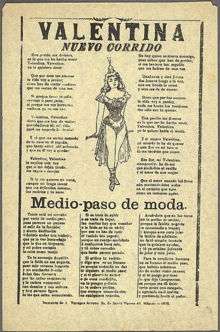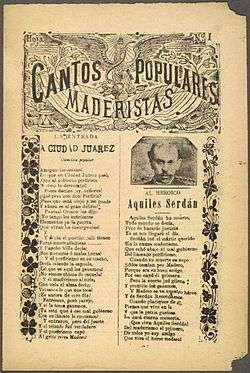Corrido

The corrido (Spanish pronunciation: [koˈriðo]) is a popular narrative song and poetry that form a ballad. The songs are often about oppression, history, daily life for peasants, and other socially relevant topics.[1] It is still a popular form today in Mexico and was widely popular during the Nicaraguan Revolutions of the 20th century. The corrido derives largely from the romance, and in its most known form consists of a salutation from the singer and prologue to the story, the story itself, and a moral and farewell from the singer.
History

Until the arrival and success of electronic mass-media (mid-20th century), the corrido served in Mexico as the main informational and educational outlet, even with subversive purposes, due to an apparent linguistic and musical simplicity that lent itself to oral transmission. After the spread of radio and television, the genre evolved into a new stage and is still in the process of maturation. Some scholars, however, consider the corrido to be dead or moribund in more recent times (see e.g. Vicente T. Mendoza, El corrido mexicano, 1954). In more rural areas where Spanish and Mexican cultures have been preserved because of isolation, the romance has taken on other forms related to the corrido as well. In New Mexico, for example, a story-song emerged during the colonial period that was known as an Indita, which loosely follows the format of a corrido, but is chanted rather than sung, similar to a Native American chant, hence the name Indita.
The earliest living specimens of corrido are adapted versions of Spanish romances or European tales, mainly about disgraced or idealized love, or religious topics. These, that include (among others) "La Martina" (an adaptation of the romance "La Esposa Infiel") and "La Delgadina", show the same basic stylistic features of the later mainstream corridos (1/2 or 3/4 tempo and verso menor lyric composing, meaning verses of eight or less phonetic syllables, grouped in strophes of six or less verses).
Beginning with the Mexican War of Independence (1810–1821) and culminating during the Mexican Revolution (1910–1921), the genre flourished and acquired its "epic" tones, along with the three-step narrative structure as described above.
.jpg)
Some corridos may also be love stories. Also, there are corridos about women ("La Venganza de Maria," "Laurita Garza," "La tragedia de Rosita and la adelita") and couples, not just about men. Some even employ fictional stories invented by their composers.
Prior to widespread use of radio, popular corridos were passed around as an oral tradition, often to spread news of events (for example, La cárcel de Cananea) and popular heroes and humor to the population, many of whom were illiterate prior to the post-Revolution improvements to the educational system. Academic study of corridos written during the Revolution shows that they were used as a means to communicate news throughout Mexico as a response to the propaganda being spread in the newspapers which were owned by the corrupt government of Porfirio Díaz. Sheet music of popular corridos was sold or included in publications. Other corrido sheets were passed out free as a form of propaganda, to eulogize leaders, armies, and political movements, or in some cases to mock the opposition. The best known Revolutionary corrido is La cucaracha, an old song that was rephrased to celebrate the exploits of Pancho Villa's army and poke fun at his nemesis Venustiano Carranza.
With the consolidation of "Presidencialismo" (the political era following the Mexican Revolution) and the success of electronic mass-media, the corrido lost its primacy as a mass communication form, becoming part of a folklorist cult in one branch and, in another, the voice of the new subversives: oppressed workers, drug growers or traffickers, leftist activists and emigrated farmworkers (mainly to the USA). This is what scholars designate as the "decaying" stage of the genre, which tends to erase the stylistic or structural characteristics of "revolutionary" or traditional corrido without a clear and unified understanding of its evolution. This is mainly signified by the "narcocorrido", many of which are egocentric ballads paid for by drug smugglers to anonymous and almost illiterate composers (more about this assertion here), but with others coming from the most popular norteño and banda artists, and written by some of the most successful and influential ranchera composers.
 |
1. La Cucaracha (chorus only)
Performed by Sean Buss & Elisa |
| Problems playing this file? See media help. | |

In the mestizo-Mexican cultural area the three variants of corrido (romance, revolutionary and modern) are both alive and sung, along with popular sister narrative genres, such as the "valona" of Michoacán state, the "son arribeño" of the Sierra Gorda (Guanajuato, Hidalgo and Querétaro states) and others. Its vitality and flexibility allow original corrido lyrics to be built on non-Mexican musical genres, such as blues and ska, or with non-Spanish lyrics, like the famous song El Paso by Marty Robbins, and corridos composed or translated by Mexican indigenous communities or by the "Chicano" people in the USA, in English or "Spanglish". The corrido was, for example, a favorite device employed by the Teatro Campesino led by Luis Valdez in mobilizing largely Mexican and Mexican-American farmworkers in California during the 1960s.
Corridos have seen a renaissance in the 21st century. Contemporary corridos feature contemporary themes such as drug trafficking (narcocorridos), immigration, migrant labor and even the Chupacabra.[2]
Form
Corridos, like rancheras, have introductory instrumental music and adornos interrupting the stanzas of the lyrics. However, unlike rancheras, the rhythm of a corrido remains fairly consistent. The corrido has a rhythm similar to that of the European waltz; rancheras can be banda, played at a variety of rhythms. Corridos often tell stories, while rancheras are for dancing.
Like rancheras, corridos can be played by mariachi, norteño, duranguense, Tejano and grupera bands. The instruments used to play the song differ with the type of band that plays the corrido.
Notable corrido singers
- Concha Michel
- Los Cadetes de Linares
- Carlos y Jose
- Chalino Sánchez
- Ramon Ayala
- Roberto Tapia
- Los Tigres del Norte
- Cipriano Vigil
- José Alfredo Jiménez
- Beto Quintanilla
- Rigo "El Gansito" Solis
- Los Tucanes de Tijuana
- Martin castillo
- Gerardo Ortiz
- Xavier Vaquera
Ariel Camacho Regulo Caro
Musical characteristics
The corrido was originally performed as a melodically simple tune with guitar accompaniment. It was performed in waltz time and now commonly adopts a polka rhythm. Since the commercialization of the corrido, it is often performed by conjuntos produced professionally by recording companies.
Films
- 2006 - Al Otro Lado (To the Other Side). Directed by Natalia Almada.
- 2007 - El Violin (The Violin) directed by Francisco Vargas
- 2008 - El chrysler 300: Chuy y Mauricio Directed by Enrique Murillo
- 2009 - El Katch (The Katch) Directed by Oscar Lopez
See also
- Norteño
- Tambora Sinaloense
- Duranguense
- Ranchera
- Corridos De Caballo
References
- ↑ Walkowitz, Daniel. Memory and the impact of political transformation in public space. p. 255.
- ↑ Davis, Mike. Ecology of Fear: Los Angeles and the Imagination of Disaster. p. 269.
Further reading
- Americo Paredes. With His Pistol in His Hand: A Border Ballad and its Hero (Austin: University of Texas Press, 1958)
- Richard Flores. "The Corrido and the Emergence of Texas-Mexican Social Identity" (Journal of American Folklore, Vol. 105, Spring 1992)
- Dan Dickey. The Kennedy Corridos: A Study of the Ballads of a Mexican American Hero (Center for Mexican-American Studies, University of Texas at Austin, 1978)
- Merle Simmons. The Mexican Corrido as a Source of an Interpretive Study of Modern Mexico, 1870–1950 (Bloomington: Indiana University Press, 1957).
- Jhio Gabriel Agbas "The Corrido is a popular narrative song and poetry form, a ballad. The songs are often about oppression, history, daily life for peasants, and other socially relevant topics."
External links
- Narcocorrido, includes a variety of information about the contemporary scene, including a page of topical corrido lyrics and one on the censorship of corridos in Mexico.
- The Genesis and Development of the Mexican Corrido with complementary information and a research proposal. (in Spanish)
- Corridos performed by folklorist Dr. Americo Paredes from the Texas - Mexico border.
- Summary of the corrido for the Handbook of Texas Online.
- Corridos Sin Fronteras - Ballads Without Borders - This bilingual web site teaches the history of Mexico through corridos.
- The Mexican corrido A short overview with archive photos, audio samples and translations (also in Spanish.)
- Mexico: Trouble in Culiacán, Pulitzer Center on Crisis Reporting